Physical Address
304 North Cardinal St.
Dorchester Center, MA 02124
Fine-needle aspiration biopsy (FNAB) of mesenchymal lesions is still controversial. It is not as widely accepted as FNAB of solid organs. One of the possible reasons for the low acceptance might be the inexperience of most cytopathologists as soft tissue neoplasms are relatively uncommon. Sarcomas represent less than 1% of all malignancies and mostly are treated in tertiary care centers. There is also a generalized perception that FNAB of mesenchymal lesions does not provide enough information for treatment. Despite all criticisms and limitations of FNAB in the evaluation of mesenchymal neoplasms, it is important to know the cytological features of mesenchymal neoplasms. It is important to distinguish primary mesenchymal neoplasms from metastatic epithelial or melanocytic neoplasms involving the bone and soft tissue. Similarly, metastatic mesenchymal lesions should be distinguished from primary or metastatic epithelial lesions in the lung.
A multidisciplinary approach is essential in the evaluation of FNAB of mesenchymal neoplasms. Clinico-radiological information such as patient age, tumor size, anatomic location, border characteristics, and vascularization are all useful features to lead to the correct differential diagnoses. Clinical history has a major impact on the diagnostic accuracy of mesenchymal neoplasms, particularly in bone lesions. The patient's age is important, as in any FNAB. In the particular case of small round cell mesenchymal neoplasms, it is important to make use of the appropriate ancillary studies. For instance, the differential diagnoses of a small round cell neoplasm in a child should include markers to rule out Ewing sarcoma (ES), rhabdomyosarcoma, and lymphoma, whereas a round cell tumor in an older adult should include markers for round cell liposarcoma. The site of the tumor may aid in determining the nature of the lesion, since some lesions such as epithelioid sarcoma are much more common in the extremities than well-differentiated liposarcomas, which are more commonly present in the retroperitoneum. A definite cytological diagnosis must be based on a combination of the cytological findings (i.e., adequate specimen, cytomorphology) and results of ancillary studies (immunohistochemistry, flow cytometry, cytogenetic analysis, electron microscopy), along with the clinical and/or radiographic data. An interesting prospect is the development of fluorescent in situ hybridization (FISH) tests that can be applied to cytology material. FISH probes targeted against specific translocations can prove very useful in evaluating sarcomas with recurrent translocations. Early studies have shown good results in evaluating cases of synovial sarcoma, ES, and rhabdomyosarcoma. Close interaction between the clinician and cytopathologist is also an essential component to the success of FNAB in the workup of soft tissue sarcomas. The accuracy of FNAB to subtype previously undiagnosed soft tissue sarcomas varies from 21% to 76%. It is largely dependent on the experience of the cytopathologist. In one of the largest series, FNAB of soft tissue lesions proved to be more accurate in the histological subtyping of cases of pediatric sarcomas (92%) than in that for adult sarcomas (52%).
Most authors recommend dividing mesenchymal lesions into five major cytomorphological subtypes based on the predominant morphology: myxoid, spindle cell, round cell, pleomorphic, and polygonal/epithelioid cells. These cytomorphological subtypes are not mutually exclusive and some overlapping can be seen. For instance, a myxoid fibrosarcoma can be included in either myxoid or spindle cell category. Similarly, some of the pleomorphic tumors might have overlapping features with polygonal/epithelioid lesions.
The histological subclassification of soft tissue tumors according to cell lineage can be very difficult, particularly in the absence of abundant material for ancillary studies. Fortunately, histological grading is more important for the clinical management than for histological subclassification according to cell lineage. Histological grading of soft tissue sarcomas has been reported as one of the most important criteria for predicting metastases. The clinical management of most sarcomas, except pediatric small round cell tumors, is based mainly on anatomic location and stage, in which histological grade is part of the stage criteria. The most commonly used histological grading systems are that proposed by Costa and colleagues from the National Cancer Institute (NCI) and that by Guillou and coworkers from the Fédération Nationale des Centres de Lutte Contré le Cancer (FNCLCC). A two-tier system (low- or high-grade lesion) is favored in cytology specimens over a three-tier system (grades 1–3), because the latter shows only moderate correlation between the histological and cytology grade.
The ability to accurately grade soft tissue lesions is very dependent on cellular morphology. Cases classified as pleomorphic, epithelioid, and round cell are mostly high-grade lesions. For instance, mesenchymal neoplasms with epithelioid morphology are represented mostly by high-grade mesenchymal neoplasms such as epithelioid leiomyosarcomas, epithelioid angiosarcomas, and epithelioid gastrointestinal stromal tumor. Spindle cell lesions, conversely, can be difficult cases to be graded on FNAB material as the distinction of non-neoplastic spindle cell proliferations from low-grade spindle cell neoplasms can be challenging. Fibrillar ground substance, nuclei with neural (wavy) appearance, and clusters with a tissue culture appearance are features suggestive of low-grade spindle cell lesions. Benign or low-grade spindle cell lesions in the retroperitoneum and thorax are usually associated with low cellularity, fine chromatin pattern, and absence of macronucleoli. The criteria mostly associated with high-grade spindle cell lesions are cellular atypia and/or pleomorphism. Other helpful criteria are identification of features suggestive of specific sarcomas, such as nuclei with fish-hook appearance in leiomyosarcomas and intracytoplasmic iron deposits in angiosarcomas. Myxoid lesions can also be difficult to classify due to sampling issues or lack of marked cellular atypia in some high-grade myxoid lesions.
A high incidence of specific and primary genetic alterations has been identified in soft tissue neoplasms in recent years. These genetic alterations have allowed a more accurate diagnosis, but also allowed the selection of therapies in cases in which target therapy was available. The detection of the molecular alterations has greatly benefited from the addition of molecular cytogenetic (FISH; array-based comparative genomic hybridization (aCGH); and single nucleotide polymorphism (SNP) array) and molecular approaches (e.g., reverse transcription–polymerase chain reaction (RT-PCR) and sequencing technology) to the diagnostic tools available. The sensitivity and accuracy of detecting non-random chromosomal imbalances and/or structural rearrangements (e.g., translocations), as well as specific gene mutations in soft tissue tumors, including assessment in formalin-fixed, paraffin-embedded (FFPE) tissues, has improved dramatically. Many of these tests have also been validated in cytology specimens.
It is important to remember that soft tissue tumors represent a heterogeneous group of tumors, where some tumors show specific alterations, while others are associated with multiple and sometimes complex chromosomal changes and nonspecific genetic alterations. At this moment, these latter lesions are not routinely analyzed due to their genomic complexity and instability. The tumors with specific alterations are commonly represented by translocations that result in the production of chimeric genes encoding for abnormal, oncogenic proteins that are important in the pathogenesis of these tumors. Alternatively, some soft tissue tumors feature specific activating or inactivating mutations within oncogenes or tumor suppressor genes, respectively. About one-third of all sarcomas exhibit a non-random chromosomal translocation, which is frequently present as the sole karyotypic aberration. This abnormality is present in the original tumor as well as in the metastases, serving as a diagnostic marker for recurrences. The chromosomal translocations most commonly result in the production of a highly specific, novel chimeric gene. Although this translocation might be a sensitive marker in some instances, the translocation can be seen in two or more unrelated neoplasms, which could be soft tissue tumors or not. It is important to remember that both cytogenetic and molecular genetic variant translocations can be identified in the soft tissue tumors. These cytogenetic variant translocations can arise from a rearrangement of one consistent gene with differing chromosomal translocation partners. Molecular variants can also happen due genomic breakpoint differences that lead to distinct fusion product exon combinations.
Specific cytogenetic translocations or other rearrangements can be used to differentiate benign soft tissue tumors from malignant ones, such as in cases of lipomatous neoplasms. For instance, identification of rearrangements of 12q14-15 and the underlying HMGA2 gene is helpful to distinguish lipoma from malignant sarcomas such as atypical lipomatous tumor/well-differentiated liposarcoma. This finding might be helpful particularly in small biopsy specimens including FNA specimens where not all histological features might be present. Cytogenetic studies of conventional lipoma have revealed rearrangements of 12q14-15 and the underlying HMGA2 gene as most common genetic mutations in these neoplasms. In contrast, the presence of a supernumerary ring or marker chromosomes (often as the sole anomaly) containing amplification of the 12q14-15 region and corresponding tumor-associated genes (in particular MDM2 and CDK4) are usually seen in atypical lipomatous tumor/well-differentiated liposarcoma.
Soft tissue tumors might present with activating oncogenic mutations in addition to specific translocations or fusion genes. An example is the case of gastrointestinal stromal tumors, which demonstrate a primary mutation at one of three sites in 85% of the cases: KIT exon 11 mutations (approximately 65%), KIT exon 9 mutations (10%), and PDGFRA exon 18 mutations (10%). The different types of mutations are associated with anatomic locations and prognosis.
Different platforms have been used to identify mesenchymal tumor-specific abnormalities including conventional cytogenetic, FISH, RT-PCR, and sequencing analyses. Some of them have been validated for analysis of cytology specimens such as FISH, while others, such as next generation sequencing, have not been completely validated for use in cytological material.
Fine-needle biopsy or aspiration specimens can be analyzed; however, a large amount of material might be required, making it difficult to obtain consistent results. Notably, a limited sample size may also be more restrictive for a few neoplasms, such as benign adipose tissue tumors, which often have a low cell density per volume unit.
Chromosome-specific probes labeled with fluorescent dyes (FISH) represent the basis of fluorescence in situ hybridization. This technique can be performed on cytology specimens such as touch preparations and cytospin preparations. One limitation for this assay is the need for knowledge of candidate translocation, amplification of an oncogene locus, or loss of a tumor suppressor gene locus in order to better select the probes to be used. FISH can be helpful in deciphering the origin of marker chromosomes, ring chromosomes, and cryptic or complex chromosomal rearrangements, and in identifying tumor-specific anomalies.
RT-PCR analysis is a sensitive tool to detect specific gene rearrangements that are present in some types of soft tissue tumors. It can detect abnormalities even if they are present in a limited number of cells in the sample. It can be performed in cell block specimens as well as smears. It requires knowledge of the chromosomal abnormalities that are being considered for the soft tissue tumor in question. Unfortunately, not all soft tissue tumors have characteristic fusion-gene transcript, limiting the usefulness of this assay.
Detection of activating or inactivating missense mutations, deletions, and insertions can be achieved by DNA sequencing analysis of specific genes. The DNA sequencing can be evaluated by several methods including Sanger sequencing and pyrosequencing. Sanger sequencing allows for selection of either a full gene or specific exons and splice sites to sequence in cell block specimen. One limitation is the large amount of high-quality neoplastic DNA required for analysis. Also, Sanger sequencing has low analytical sensitivity and it is a time-consuming assay. The advent of pyrosequencing represents an alternative due to its higher sensitivity that permits the sequencing of short DNA fragments (10–100 bp) within a gene.
Next-generation sequencing is a promising assay for cytology specimens that can be performed through several high-throughput sequencing technologies. These technologies allow the ability to process millions of sequence reads and generate large datasets. Next-generation sequencing will allow the analysis of hundreds of genes in the same sample and it is anticipated to represent the next frontier in tumor mutation analysis with the promise of an improved understanding of carcinogenesis and a more precise classification system with discovery of new therapeutic targets.
Exciting new technologic innovations in molecular diagnostics are on the horizon and soon will allow for even higher resolution analysis of the genetic anomalies underlying the pathogenesis of soft tissue tumors. Moreover, advancements in soft tissue pathology, not only at the DNA level but also at the RNA level through transcriptome analysis and at the epigenetic level through genome-wide analysis of promoter methylation or chromatin acetylation, can be anticipated. These advancements will likely not only affect diagnosis and classification schemes, but, perhaps more important, personalized therapy based on identified targets within a given tumor can be employed for improved outcomes.
A lesion is considered to be of adipose tissue origin when at least some of the neoplastic cells demonstrate fatty differentiation, which can be manifested by clear vacuolated cytoplasm resulting from lipid accumulation. The cytoplasmic vacuoles must be clear and sharply delimited and bulge against or distort the nucleus in order to be recognized as lipidic. Adipocytic tumors represent the largest group of mesenchymal tumors, and liposarcomas represent the single most common type of soft tissue sarcoma.
Lipomas usually present between the ages of 40 and 60 years and are rare in children. The most common sites are the subcutaneous tissue and deep soft tissues. They usually present as a painless soft tissue mass, except when they compress peripheral nerves. Imaging studies show a homogeneous soft tissue that demonstrates fat saturation. Conventional lipomas are characterized histologically by lobules of mature adipocytes. FNAB of lipoma shows the presence of clusters of adipose tissue composed of bland adipocytes, without associated “chicken-wire” vascular network or myxoid changes. The cells are cytologically indistinguishable from the surrounding adipose tissue. Clinico-radiological correlation is required to make the diagnosis of lipoma and rule out a sampling miss.
Bland adipocytes
No “chicken-wire” vascular network or myxoid changes.
Lipoblastomas are localized or diffuse tumors resembling fetal adipose tissue. They are most common in the first 3 years of life and have a male predilection. They are commonly located in the extremities, but they can be seen in other locations such as mediastinum and retroperitoneum. The lesions present as slowly growing masses involving subcutaneous tissue or infiltrating muscle. Histologically, lipoblastoma is composed of lobules separated by connective tissue, which are composed of an admixture of mature adipocytes and lipoblasts. Myxoid stroma and plexiform vascular networks are frequently seen in this tumor. FNAB of lipoblastoma shows adipocytes, lipoblasts, and spindle cells in various proportions and arranged in clusters or single cells. A vascular network is noted inside the clusters. Abundant myxoid extracellular material and naked oval nuclei can be seen. The main differential diagnosis is liposarcoma, which shows nuclear atypia, a feature not seen in lipoblastoma. Lipoblastomas are commonly associated with aberrations in chromosome 8.
Presence of both mature adipocytes and lipoblasts
Myxoid stroma and plexiform vascular network
No atypia.
Spindle cell and pleomorphic lipomas are subcutaneous lesions, which occur mainly in the head and neck region of male patients. Most tumors are asymptomatic and occur in the sixth decade of life. They have a benign behavior and can be conservatively excised. Spindle cell lipomas are characterized by spindle cells arranged in parallel clusters between the adipocytes and associated with thick collagen bundles. Mast cells are frequently noted in between the spindle cells. The cytological findings of spindle cell lipomas include a population of adipocytes, spindle cells, and collagen bundles. The spindle cells have mild nuclear enlargement, focal nuclear irregularities, rare intranuclear inclusions, and occasional small nucleoli. No lipoblasts are present. Pleomorphic lipomas are clinically similar to spindle cell lipoma. Pleomorphic lipoma is a term that should be used only in tumors located in the back, neck, or shoulders. They are characterized by the presence of a variable number of cells with enlarged nuclei, including floret cells, in close association with adipocytes and collagen bundles. The FNAB shows a population of floret cells and pleomorphic cells admixed with adipocytes and spindle cells. The floret cells show multiple enlarged hyperchromatic nuclei arranged in a circle or semicircle. No atypical lipoblasts or capillary network is present. The diagnosis must be given with care and correlated with the clinical presentation because pleomorphic lipomas can be misdiagnosed as an anaplastic carcinoma or liposarcoma.
A population of adipocytes, spindle cells, and collagen bundles
Spindle cells with mild nuclear enlargement, focal nuclear irregularities, and rare intranuclear inclusions
No lipoblasts.
Floret cells and pleomorphic cells admixed with adipocytes and spindle cells
Floret cells with multiple enlarged hyperchromatic nuclei arranged in a circle or semicircle
No atypical lipoblasts or capillary network.
Hibernoma is a benign tumor composed of brown fat cells with granular, multivacuolated cytoplasm. It is more common around the third and fourth decade of life and there is slight male predominance. The more frequent sites of involvement are the subcutaneous tissue in the thigh, trunk, upper extremity, and head and neck. Hibernomas present as brown fat cells with pale to variably eosinophilic cytoplasm ( Fig. 18-1A ). Multivacuolated lipoblast-like cells can be seen, but mitotic figures or atypia are unusual. Hibernomas are near-diploid or pseudo-diploid at a genetic level and are associated with involvement of 11q13 in structural rearrangements. The FNAB findings include round, brown, fat-like cells with uniform, small cytoplasmic vacuoles and small, round nuclei. Delicate branching capillaries are usually seen ( Fig. 18-1B ). Cytogenetics might be helpful to confirm the diagnosis as most hibernomas have breakpoints in chromosome 11q, with clustering to 11q13.
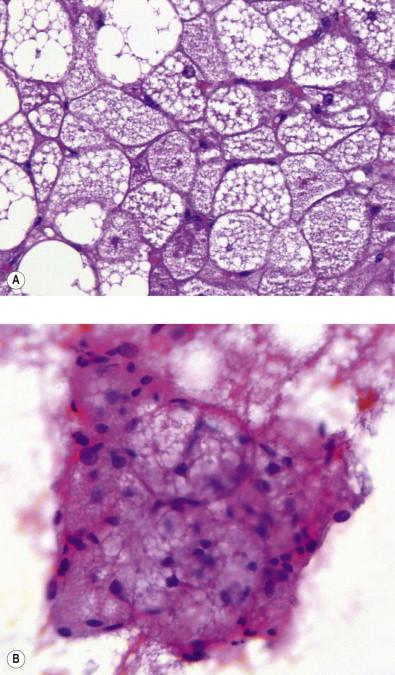
Round cells with small cytoplasmic vacuoles and small, round nuclei
Delicate branching capillaries present
Chromosome 11q breakpoint.
Atypical lipomatous tumors have been recognized by the 2002 World Health Organization (WHO) classification as synonymous with well-differentiated liposarcoma. The prognosis is related to the resectability of the lesion. They represent 40% of all liposarcomas with a peak incidence in the sixth decade of life and they equally affect men and women. The most common sites include deep soft tissue of the extremities, retroperitoneum, paratesticular area, mediastinum, and subcutaneous tissue. These lesions range from small to very large in size and are usually asymptomatic. Histologically, they can be subdivided into lipoma-like, sclerosing, inflammatory, and spindle cell. The most common type is the lipoma-like variant, which is characterized by a proliferation of adipocytes with varying cell sizes. Histological sections show adipocytes and stromal cells with focal nuclear atypia associated with hyperchromasia. Mono- or multivacuolated lipoblasts might be also seen. FNAB smears usually show the presence of lipoblasts scattered throughout the aspirate smears with occasional large cells containing multilobulated nuclei. It is very difficult for FNAB to distinguish subcutaneous fat, lipoma, or well-differentiated liposarcoma, as all of these lesions may contain areas of relatively normal-appearing adipose tissue. Nuclear immunoreactivity for MDM2 and/or CDK4 is usually seen as well as the presence of supernumerary ring and giant marker chromosomes.
Sclerosing well-differentiated liposarcoma is more commonly seen in the retroperitoneum and paratesticular area. It is characterized by the presence of scattered bizarre stromal cells with hyperchromatic nuclei associated with multivacuolated lipoblasts. The cells are present in a dense collagenous stroma. These tumors are characterized cytologically by lipoblasts, atypical fibroblasts, multinucleated cells, adipocytes, and delicate, dispersed collagen.
Inflammatory well-differentiated liposarcoma is rare and occurs most often in the retroperitoneum. At a histological level, it is characterized by an inflammatory infiltrate associated with an atypical adipocytic cell population and bizarre multinucleated stromal cells. The inflammatory infiltrate presents as lymphoplasmacytic aggregates. The FNAB of inflammatory well-differentiated liposarcoma shows numerous small lymphoid cells and plasma cells, admixed with scattered atypical cells. These atypical cells display multiple or hyperlobated nuclei with coarse chromatin and abundant ill-defined cytoplasm.
Scattered lipoblasts
Occasional large cells containing multilobated nuclei with coarse chromatin and abundant ill-defined cytoplasm
Scattered bizarre stromal cells with hyperchromatic nuclei (sclerosing well-differentiated liposarcoma)
Dispersed inflammatory cells, predominantly lymphoid cells and plasma cells (inflammatory well-differentiated liposarcoma)
Nuclear immunoreactivity for MDM2 and/or CDK4
Supernumerary ring and giant marker chromosomes.
Dedifferentiated liposarcoma is defined as the transition from a well-differentiated liposarcoma to non-lipogenic sarcoma of variable histological grade, usually measuring at least several millimeters in diameter. The dedifferentiation occurs in 10% of well-differentiated liposarcomas, a risk apparently higher in deep-seated lesions. There is no sex predilection. It is much more common to arise de novo than as a recurrence. The most common site is the retroperitoneum followed by the extremities. It is extremely rare in subcutaneous tissue. The clinical presentation is usually of a large painless mass, which radiologically has a fatty and non-fatty component. Histologically, it is characterized by the presence of a sarcoma, usually high grade, in close association with a well-differentiated liposarcoma component. The most common histological appearances of the non-lipogenic sarcoma are a pleomorphic sarcoma and intermediate to high-grade myxofibrosarcoma. There are also cases of low-grade dedifferentiation characterized by a uniform population of spindle cells with mild nuclear atypia as well as lesions with heterologous differentiation such as muscle or chondroid differentiation. The FNAB of dedifferentiated liposarcoma shows a polymorphous population of round or spindle cells, including multinucleated forms, with occasional lipoblasts. Myxoid matrix and arborizing vascular structures are rarely seen. Therefore, the clue for the correct diagnosis resides in the identification of lipoblasts, which can be very difficult. Dedifferentiated liposarcomas have the same cytogenetic abnormalities as seen in well-differentiated liposarcomas, such as ring or giant marker chromosomes. Interestingly, dedifferentiated liposarcomas have a better prognosis than other types of pleomorphic sarcoma.
Polymorphous population of round or spindle cells, including multinucleated forms
Occasional lipoblasts
Myxoid matrix and arborizing vascular structures rarely seen.
Myxoid liposarcoma is the second most common type of liposarcoma. The most common primary site is deep soft tissue of the extremities. It is rare in the retroperitoneum and subcutaneous tissue. The peak age incidence is in the fourth and fifth decades of life, but it can occur in patients younger than 20 years old. Histologically, myxoid liposarcoma is characterized by a uniform population of round to oval-shaped cells and a variable number of small signet ring lipoblasts which are present in a myxoid stroma associated with a vascular network with a “chicken-wire” appearance ( Fig. 18-2A ). Usually, myxoid liposarcomas do not show nuclear pleomorphism, giant cells, abundant spindle cells, or increased mitotic activity. Areas with round cell morphology or hypercellularity are usually associated with a poor prognosis. When present, the round cell component contains solid sheets of small round cells with high nuclear to cytoplasmic (N : C) ratio, conspicuous nucleoli, and no myxoid stroma. The cytological features include myxoid background matrix, plexiform vascular network, cells with round to ovoid nuclei ( Fig. 18-2B ), and uni- or multivacuolated lipoblasts with scalloped nuclei ( Fig. 18-3 ). The cytological differential diagnosis of myxoid liposarcoma includes other tumors with a prominent myxoid component on FNAB such as myxoma, myxoid chondrosarcoma, and chordoma. Smears of intramuscular myxomas have lower cellularity and do not show any cytological atypia. The pathologist should be careful with collections of macrophages with intracellular droplets of lipid and/or mucin material which can be misdiagnosed as lipoblasts. Myxoid chondrosarcoma are characterized by the presence of chondroid differentiation and the myxoid material is metachromatic in the air-dried Giemsa-stained slides. Chordomas have a different distribution (along the spine) and the presence of physaliphorous cells and nuclear inclusions is highly suggestive of this entity. The finding of arborizing vascular structures is not pathognomonic of myxoid liposarcoma, because similar structures may also be seen in myxoid chondrosarcomas. The demonstration of the specific translocation t(12;16)(q13;p11) of myxoid liposarcoma by FISH and/or the identification of the fusion gene product CHOP-TLS can help to establish the diagnosis.
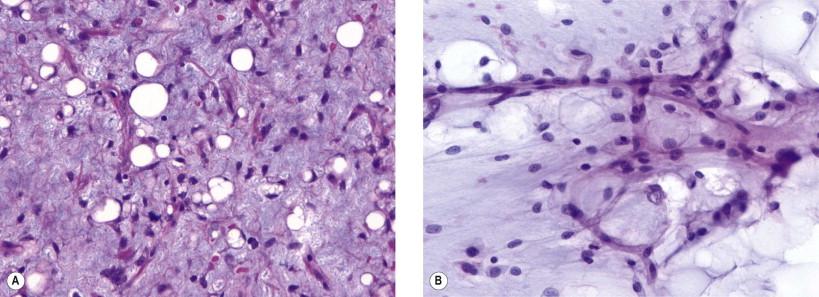
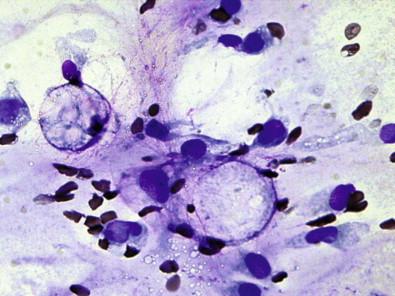
Cells with round to ovoid nuclei
Uni- or multivacuolated lipoblasts with scalloped nuclei
Myxoid background matrix
Plexiform vascular network.
Pleomorphic liposarcoma is a high-grade sarcoma characterized by the presence of lipoblasts in the absence of a well-differentiated component or a component with a different line of differentiation. It is the least common type of liposarcoma, occurs mostly in patients older than 50 years old, and has no definite sex predilection. The most common site is the extremities, followed by the trunk. These tumors are highly aggressive with a metastatic rate of approximately 50% and an overall tumor-related mortality ranging from 40% to 50%. Histologically, pleomorphic liposarcomas are characterized by a population of pleomorphic spindle cells, round cells, and multinucleated giant cells associated with pleomorphic, multivacuolated lipoblasts. The spindle cells might be arranged in fascicles. The cytological findings of pleomorphic liposarcoma include the presence of a variable number of lipoblasts, round cells, spindle cells with marked pleomorphism, coarse chromatin, prominent nucleoli, and frequent mitotic figures. Studies performed in tissue sections have shown that the cells in pleomorphic sarcoma can be positive for smooth muscle actin (SMA), S-100 protein, and keratin and focally positive for desmin. MDM2 , HGMA2 and CDK4 amplifications are absent.
Population of neoplastic cells composed of lipoblasts, round cells, and spindle cells
Marked pleomorphism
Nuclei with coarse chromatin and prominent nucleoli
Frequent mitotic figures.
Nodular fasciitis occurs most often in young adults and it is more common in the subcutaneous tissue of the upper extremities, trunk, and head and neck. It is a self-limiting fibrous neoplasm composed of fibroblastic cells arranged in loose or culture tissue-like arrangement. FNAB of nodular fasciitis usually displays cohesive clusters of epithelioid to spindle-shaped cells associated with single mesenchymal cells. These cells are present in a background of myxoid stroma.
Cohesive clusters of epithelioid to spindle-shaped cells
Single mesenchymal cells in a background of myxoid stroma
Myxoid stroma.
Proliferative fasciitis and proliferative myositis occur in middle-aged and old adults and they are more common in the extremities, followed by trunk. They are mass-forming lesions composed of ganglion-like cells associated with plump fibroblastic and/myofibroblastic cells. FNAB demonstrates low cellularity with fibroblasts arranged singly or in clusters, relative abundance of giant ganglion cell-like.
Cohesive clusters of epithelioid to spindle-shaped cells
Presence of ganglion-like cells.
Myositis ossificans is a localized, self-limiting lesion characteristically encountered during young adulthood. Myositis ossificans may develop anywhere in the body; however, the most common locations are elbow and thigh. FNAB usually yields smears with low cellularity composed of scattered multinucleated giant cells, osteoblasts, proliferating fibroblasts, and myofibroblasts. Fragments of skeletal muscle with focal degenerative features are frequently noted and they are associated with metachromatic material in Giemsa-stained slides, osteoid and scattered lymphoid cells might be seen.
Presence of multinucleated giant cells, osteoblasts, proliferating fibroblasts, and myofibroblasts
Fragments of skeletal muscle with focal degenerative features are frequently noted
Metachromatic material in Giemsa-stained slides
Osteoid material.
Fibromatosis are tumors characterized by infiltrative growth but with benign-appearing cellular features. Occurring at almost every site of the body, the exact cause is unknown. Trauma and familial predisposition have been postulated. These tumors are often very aggressive locally, but rarely metastatic. Wide excision is the only curative means but surgery may stimulate additional growth. The degree of atypia seems to increase with increasing recurrences. Tumors remaining after surgery may be radiated for local control. Fibromatosis occurs in both childhood and adult life. Childhood fibromas include fibromatosis coli, infantile digital fibromatosis, aponeurotic fibroma, and congenital fibromatosis.
Fibromatosis of adulthood can be superficial or deep, usually slow growing and painless. Abdominal wall fibromatosis or desmoid tumors are more common in women of childbearing age and may be associated with pregnancy.
The FNAB of fibromatosis yields variable cellularity and may even be paucicellular due to the presence of collagen. Fragments of connective tissue with fibroblasts and myofibroblasts with bland nuclei, hyperchromasia but little atypia, and no mitoses are seen. Nuclei may be stripped of cytoplasm. The background is usually clean, and strands of collagen may be present. These spindle-shaped cells can be mistaken for those of a well-differentiated sarcoma, either leiomyosarcoma or fibrosarcoma.
Variable cellularity
Connective tissue and myofibroblasts
Spindle-shaped cells with stripped nuclei.
Fibrosarcoma is a spindle-shaped malignant tumor of fibroblasts not often encountered in cytology practice because true fibrosarcomas are rare. According to DeMay, fibrosarcoma is often in the differential diagnosis of spindle cell neoplasms, but is seldom the final diagnosis. Other spindle cell sarcomas such as malignant fibrous histiocytoma (MFH), synovial sarcoma, liposarcoma, rhabdomyosarcoma (RMS), and malignant peripheral nerve sheath tumors (MPNST) are more common.
Fibrosarcoma can occur at any anatomic site. This tumor is distinct clinically from nerve tumors and, unlike fibromatosis, does not occur in the palm of the hand or the sole of the foot. Deep, rather than superficial, fibrosarcomas are more often encountered and are aggressive; they commonly metastasize to the lungs. Fibrosarcomas are associated with radiation exposure and are a long-term side-effect of radiation therapy for lymphomas and other tumors. Prognosis is related to grade, which can be determined in cytological material.
FNAB of fibrosarcomas are cellular and range in appearance from single cells to cohesive tissue fragments. Fibrosarcoma can demonstrate a “herringbone” growth pattern. There may be matrix present but the amount varies with the amount of tumor cellularity; the more cellular the specimen, the less matrix seen. The cells are spindle with atypical nuclei that are round to ovoid. As with most malignant nuclei, the nuclear membranes are irregular. The chromatin pattern is unusually fine for such an aggressive neoplasm and nucleoli are rarely seen. Mitotic figures should be apparent in cytologic preparations. The tumor background is necrotic and hemorrhagic and the hemorrhage may obscure the diagnostic cells, especially if the tumor is paucicellular with large amounts of matrix material. Vimentin is positive, but generally no other immunohistochemical stains will mark fibrosarcoma. Because vimentin is so nonspecific, the diagnosis is best suggested on morphologic appearance alone. Past history of radiation exposure is also helpful in making the diagnosis.
History of radiation exposure
Cellular specimen in “herringbone” pattern
Spindle-shaped cells
Round-to-oval nuclei with irregular membranes
Fine chromatin pattern
Mitosis, necrosis, hemorrhage.
Extrapleural fibrous tumors are uncommon tumors that occur in almost any organ site and affect equally men and women. Histologically, the tumors have a patternless architecture characterized by hypocellular and hypercellular areas associated with hemangiopericytoma-like branching vessels. The tumors are composed of ovoid to spindle-shaped cells with scant cytoplasm. FNAB demonstrates oval to polygonal tumor cells with cellularity ranging from scant to moderate. Most cells were dispersed singly, but irregular, loose aggregates of cells enmeshed in a collagenous matrix were also noted. The nuclei were uniformly bland, with evenly distributed, finely granular chromatin. All cases were immunoreactive for CD34.
Oval to polygonal tumor cells with cellularity ranging from scant to moderate
Single cells and loose aggregates
Collagenous matrix
Immunoreactivity for CD34.
Myxofibrosarcoma is one of the most common sarcomas in the elderly. These tumors occur mainly in the limbs with half of them arising in the dermis and subcutaneous tissue. Histologically, myxofibrosarcoma can show a range of cellularity and pleomorphism, but all cases show distinctive nodular growth with incomplete fibrous septa and myxoid stroma. FNABs are usually cellular and composed of small spindle-shaped and stellate cells with elongated nuclei containing small inconspicuous nucleoli. Cytoplasm was pale with elongated processes. Clusters of wavy spindle-shaped cells, round cells without specific pattern, moderate cytonuclear atypia, and abundant myxoid background as well as curvilinear vascular structures are frequently noted. The differential diagnoses include other myxoid lesions such as myxoid MFH, myxoid liposarcoma (MLP), myxoid dermatofibrosarcoma protuberans (DFSP), and myxoma.
Limb location
Clusters of wavy spindle-shaped cells, round cells without specific pattern, moderate cytonuclear atypia, and abundant myxoid background
Small spindle-shaped and stellate cells with elongated nuclei
Abundant myxoid stroma
Curvilinear vascular structures.
Myofibroblastomas are uncommon tumors that occur chiefly in breast parenchyma. The tumors are composed of spindle-shaped cells in a collagenous stroma. The cell nuclei are grooved and slightly irregular, imparting a wavy microscopic appearance. Heterologous elements such as fat, cartilage, and smooth muscle may be present. The cells stain for desmin, SMA, and CD10 or CALLA. Cytokeratins and S-100 immunostains are negative. There are no good cytologic descriptions of the myofibroblastic subtypes known as intranodal myofibroblastoma or hemorrhagic spindle cell tumor.
Breast more often than other sites
Spindled cells in a collagenous stroma
Grooved “wavy” nuclei
Fat, cartilage, and smooth muscle sometimes present.
This is a distinctive neoplasm characterized by bland spindle cells arranged in a whorling pattern and curvilinear vessels, which are associated with extensive areas of collagenized and myxoid zones. Cytological features included clusters of bland spindle and round/polygonal cells embedded in a collagenous and myxoid matrix along with dissociated, uniform or slightly/moderately pleomorphic spindle cells, bare nuclei and fragments of collagen and myxoid tissue in varying proportions. At a molecular level, these lesions demonstrate FUS-CREB3L2 or FUS-CREB3L1 gene fusion.
Bland spindle and round/polygonal cells embedded in a collagenous and myxoid matrix
Presence of FUS-CREB3L2 or FUS-CREB3L1 gene fusion.
Sclerosing epithelioid fibrosarcoma is a rare neoplasm that occurs mostly in the extremities. It is composed of epithelioid fibroblasts arranged in distinct cords and nests in a densely fibrotic and hyalinized stroma. These cells are positive for MUC-4 with focal immunoreactivity for epithelial membrane antigen (EMA) and S100. FNAB shows medium-sized cell clusters with moderate overcrowding. The neoplastic cells had eccentric nuclei with oval, spindle, or cleaved morphology and fine granular chromatin and several small nucleoli.
Cells with eccentric nuclei with oval, spindle, or cleaved morphology and fine granular chromatin.
Tenosynovial giant cell tumor, also known as nodular tenosynovitis, is a circumscribed proliferation of synovial-like mononuclear cells associated with a variable number of multinucleate osteoclast-like cells, foam cells, hemosiderin-laden macrophages, and inflammatory cells. The majority of the lesions are localized and occur in adults between 30 and 50 years of age. There is a 2 : 1 female predilection. The most common sites are the fingers, followed by the wrist, ankle/foot, and knee. The typical clinical history is a painless swelling present over a long period of time, which on X-ray appears as a soft tissue mass associated with erosion of the adjacent bone. Histologically, giant cell tumor of tendon sheath is characterized by a population of mononuclear cells, giant multinucleated cells, macrophages, hemosiderin-laden macrophages, and stroma. The multinucleated cells may contain up 50 nuclei. The mononuclear cells can be round or spindle-shaped and contain round or reniform grooved nuclei. These mononuclear cells are frequently accompanied by larger epithelioid cells with glassy cytoplasm and rounded nuclei with vesicular chromatin pattern. The appearance of the macrophages ranges from xanthoma cells to hemosiderin-laden macrophages. The stroma can be hyalinized ( Fig. 18-4A ). Cytologically, giant cell tumor of tendon sheath contains multinucleate osteoclast-type giant cells and mononucleated cells resembling histiocytes and osteoblasts. Anisonucleosis is minimal and nuclear pleomorphism is absent in both single and multinucleate cells. Mitotic figures are rare. Stromal cells are usually present as single cells and are round to spindle-shaped. Nuclear grooves and intranuclear cytoplasmic inclusions are occasionally seen ( Fig. 18-4B ). The differential diagnosis includes giant cell tumor of bone and gout tophi. The cells are positive for CD68. Cytogenetics has shown a near or pseudodiploid karyotype with simple structural changes, most frequently translocations involving chromosome 1. Localized giant cell tumor of tendon sheath has a low potential for recurrence.
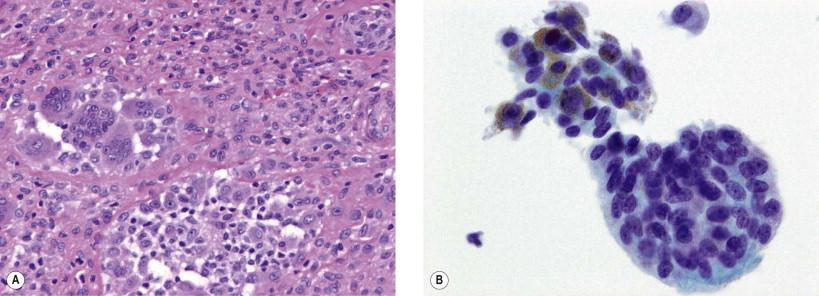
Diffuse-type giant cell tumor, a synonym for pigmented villonodular synovitis, is characterized by a proliferation of mononuclear cells associated with multinucleated cells, foamy macrophages, hemosiderin-laden macrophages, and inflammatory cells. It is a destructive lesion, which tends to occur in younger patients, mostly under the age of 40, and has a slight female predominance. The most common sites are knee and hip. The symptoms include a longstanding history of pain, swelling, and tenderness. Histologically, it is characterized by an infiltrative pattern composed of sheets of variable cellularity with cleft-like formations. The cells in this tumor present as a proliferation of small histiocytic-like cells and large cells. The histiocytic cells can have ovoid or spindle nuclei, which contain fine chromatin pattern, small nucleoli, and nuclear grooves. The larger cells have reniform nuclei, vesicular chromatin pattern, and abundant eosinophilic cytoplasm. Hemosiderin granules can be seen in these large cells. Lymphocytes can be seen in between the tumor cells. Stromal fibrosis can also be noted. Immunohistochemically, the cells are positive for CD68 and desmin stain can be noted in the large cells. The fine-needle aspiration (FNA) findings in these lesions are similar to those found in the localized form. Recurrences are common, often multiple, and may compromise joint function.
Multinucleate osteoclast-type giant cells and mononucleated cells resembling histiocytes and osteoblasts
Absent nuclear pleomorphism
Rare mitotic figures
Foamy macrophages and hemosiderin-laden macrophages
Nuclear grooves and intranuclear cytoplasmic inclusions occasionally seen.
Benign fibrous histiocytoma is most common in the subcutaneous tissue of head and neck and lower extremities. It affects mostly adults over 25 years old, with a male predominance. At a histological level, benign fibrous histiocytoma has a prominent storiform pattern and is mostly monomorphic. The cells are spindle-shaped and bland with vesicular chromatin and eosinophilic, ill-defined cytoplasm. The stroma might be myxoid or hyalinized with rare osteoclast-like giant cells. FNAB smears contain histiocytic cells with finely vacuolated cytoplasm, small bland spindle cells, and giant cells with mild atypia. Histiocytic cells are occasionally attached to vascular structures. Storiform patterns, round cells, pleomorphism, necrosis, and mitotic figures are not seen. The differential diagnosis includes low-grade fibrosarcoma, dermatofibrosarcoma protuberans, nodular fasciitis, spindle-cell malignant melanoma, and monophasic synovial sarcoma.
Small bland spindle cells with vesicular chromatin pattern
Histiocytic cells with finely vacuolated cytoplasm
Rare giant cells with mild atypia.
Plexiform fibrohistiocytic tumors occur most frequently in young patients with a median age of 14.5 years with an equal distribution between the sexes. The most common sites are the hands and wrists, followed by the lower extremities. They usually present as a poorly circumscribed subcutaneous mass, high incidence of recurrences and low rate of metastases. Histologically, they are characterized by multiple small nodules within fibrous septa; these nodules are composed of mononuclear epithelioid histiocyte-like cells, spindled myofibroblasts, and scattered multinucleated cells. FNAB reveals mononuclear spindle and histiocytic cells with abundant cytoplasm. These cells contain cytoplasmic vacuoles and granules, and display round nuclei with distinct nucleoli. Scattered bi- and multinucleated giant cells are also noted. Immunoreactivity for CD68 in the histiocytoid cells and for SMA in the myofibroblasts is seen. Local recurrence has been reported in 13–38% and lymph node metastasis has been reported in 6% of cases.
Mononuclear spindle and histiocytic cells
Abundant cytoplasm with cytoplasmic vacuoles and granules
Round nuclei with distinct nucleoli
Scattered bi- and multinucleated giant cells.
Previously termed as MFH (malignant fibrous histiocytoma), these tumors are usually high-grade sarcomas typically occurring in the extremities. They show spindle to epithelioid morphology with nuclear pleomorphism. Increased mitoses and areas of necrosis are usually noted. The morphology or immunohistochemical profile fail to demonstrate a specific line of differentiated. Genetically, these tumors show highly complex karyotypes with numerous gains and losses. Undifferentiated sarcomas with epithelioid morphology appear to be more aggressive.
Tumors of muscular origin include smooth and striated muscle with benign and malignant counterparts of both. They are commonly encountered in FNAB material in children and adults.
These benign smooth muscle tumors are frequently found in the uterus where FNAB is almost never done due to the obvious clinical diagnosis. They also occur in the gastrointestinal tract and the skin and subcutaneous tissue. Smooth muscle tumors of superficial origin often have a vascular component (angioleiomyomas) and present with pain. FNABs of these lesions are characteristically very painful.
FNAB specimens tend to be cellular with loose bundles of bland spindle cells ( Fig. 18-5 ). Cytoplasm is clearly apparent and the N : C ratio is not high. The presence of many single cells should raise the possibility of another, more aggressive, tumor such as well-differentiated leiomyosarcoma. The nuclei of benign smooth muscle tumors are round to oval with finely delicate chromatin and easily apparent nucleoli. Mitoses and necrosis are not a feature of this tumor. Cytoplasmic vacuoles are frequently present and may push the nuclei more peripherally. The appearance of cytoplasmic vacuoles and indented nuclei must be distinguished from lipomatous tumors or even epithelial cells with mucin vacuoles, although the spindle-shaped cells should serve as a clue to the muscular nature of the tumors. Palisading of the cells is frequent and in this way the aspirates may resemble those of peripheral nerve sheath tumors. Degenerative changes such as sclerosis, hemorrhage, cystic change, and calcification can be present.
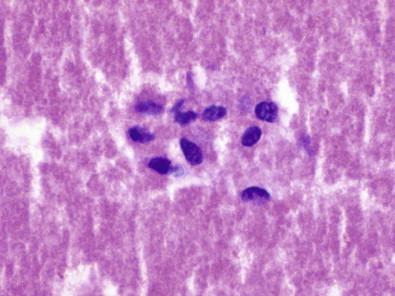
Tumor cells are positive for SMA, desmin, and h-caldesmon and are negative for S-100. Tumors originating from the gynecologic tract or those occurring in the abdomen and retroperitoneum and have a gynecologic tract origin are uniformly positive for estrogen and progesterone receptors.
Pain on aspiration of superficial lesions
Cellular preparation with loose collections of bland spindle cells
Round to oval nuclei with nucleoli
Cytoplasmic vacuoles that indent the nucleus
Degenerative changes expected.
This malignant smooth muscle tumor is found in adulthood, most frequently in the retroperitoneum, but also in association with blood vessels such as the pulmonary artery or vena cava. It can be confused with leiomyoma when small or well differentiated. Malignant smooth muscle tumors are characterized by increased mitoses, cytologic atypia, and poor cohesion ( Fig. 18-6 ). Retroperitoneal location and large size are adverse prognostic factors.
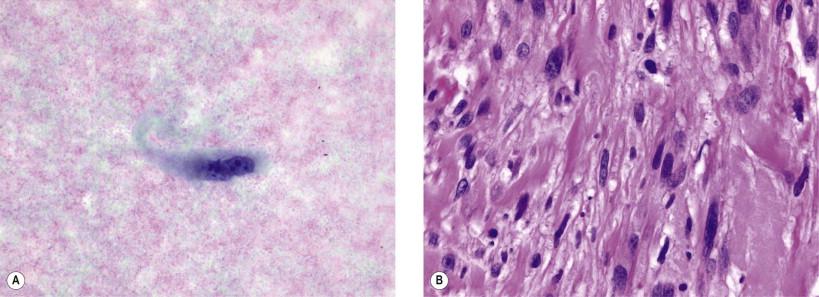
Low-grade leiomyosarcoma may be less cellular and nuclear atypia and coarse chromatin more difficult to identify. Cells may palisade similar to neurogenic tumors. It may not be possible to make a diagnosis of malignancy with accuracy in these cases, which may have to be considered suspicious for malignancy or labeled as atypical. High-grade leiomyosarcoma can be pleomorphic with necrosis and markedly abnormal-appearing cells ( Fig. 18-7 ). Multinucleation may be present. Leiomyosarcoma may express SMA, desmin, and h-caldesmon in a majority of cases. High-grade leiomyosarcoma may show squamoid cytoplasm. High-grade smooth muscle tumors may also resemble MFH ( Fig. 18-8 ). Genetically, soft tissue leiomyosarcomas have a complex karyotype with genomic instability. Metachromatic material may be found in the background of any smooth muscle tumor. Primary leiomyosarcoma of bone has been reported.
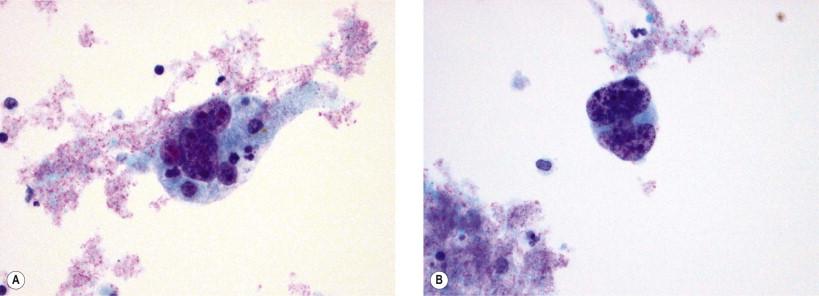
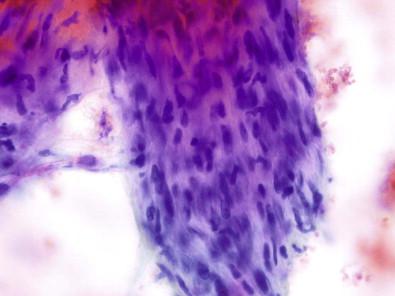
Cellular smears with many spindle cells
Atypical nuclei and multinucleation
Mitosis present
Desmin and SMA positive; myoglobin and S-100 negative
Palisading arrangement of nuclei possibly present.
Focal epithelioid or round cell features can be found in smooth muscle tumors such as round or polygonal cell shapes ( Fig. 18-9 ). Nuclear atypia is not common but intranuclear cytoplasmic vacuoles as well as vacuolated cytoplasm may be present ( Figs 18-10 , 18-11 ). Histology of this tumor does not predict its behavior, but mitotic count is important. Both the epithelioid appearance and the more classic appearance of smooth muscle may coexist. The differential diagnosis is with epithelial tumors, especially malignant ones.
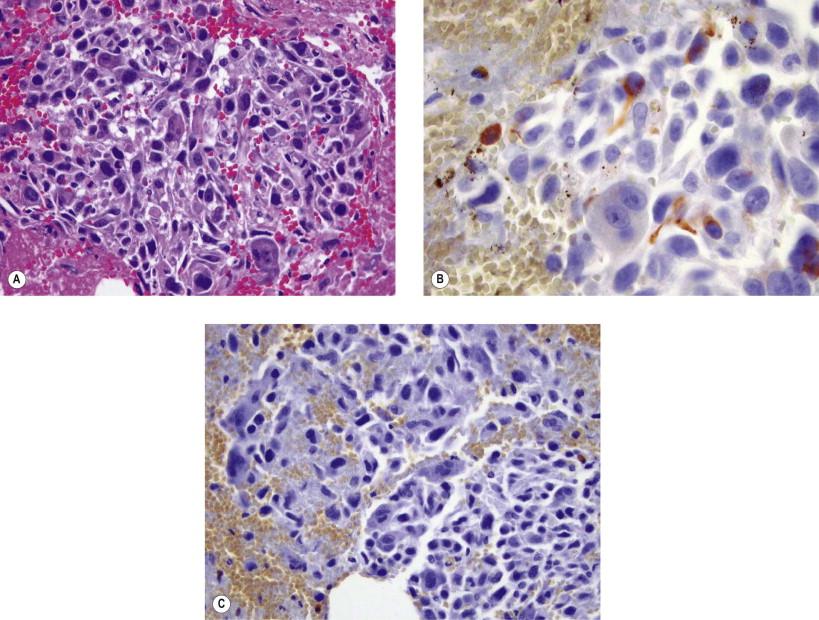
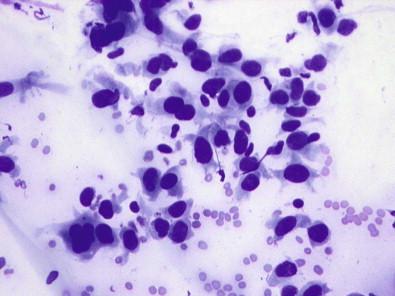
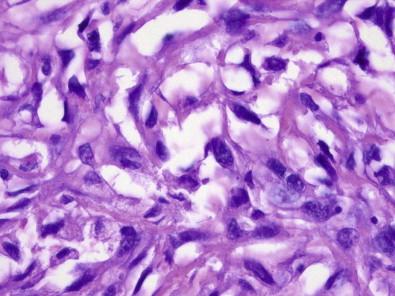
Round to polygonal cells
Nuclear atypia
Vacuolated cytoplasm
Possible biphasic pattern.
Become a Clinical Tree membership for Full access and enjoy Unlimited articles
If you are a member. Log in here